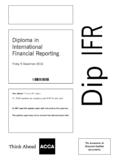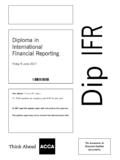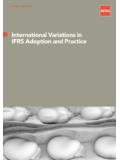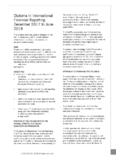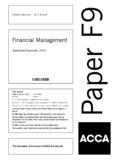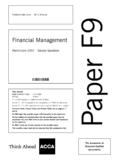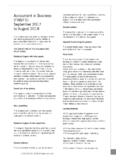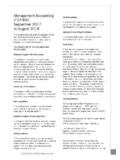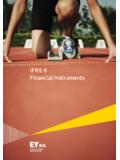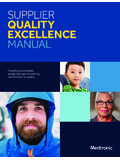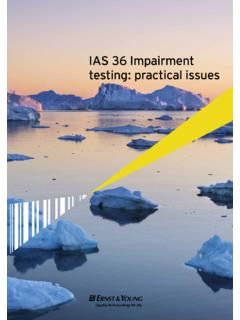Transcription of Answers - ACCA Global
1 AnswersProfessional Level Essentials Module, Paper P2 (INT)Corporate Reporting (International)June 2014 Answers1 (a) (i)Marchant Group: Statement of profit or loss and other comprehensive income for the year ended 30 April 2014$mRevenue538 Cost of sales(383) Gross profit155 Other income45 7 Administrative costs(30)Other expenses(74 69)Share of profits of associates1 5 Operating profit97 51 Finance costs(10)Finance income15 Profit before tax102 51 Income tax expense(30 5) Profit for the year72 01 Other comprehensive income: Items which will not be reclassified to profit or lossChanges in revaluation surplus2 8 Remeasurements defined benefit plan(2) Total items which will not be reclassified subsequently to profit or loss0 8 Items which may be reclassified subsequently to profit or lossLosses on cash flow hedge(3) Other comprehensive loss for the year (2 2) Total comprehensive income for the year69 81 Profit/loss attributable to: (w7)Owners of the parent60 21 Non-controlling interest11 8 72 01 Total comprehensive income attributable to.
2 $mOwners of the parent59 21 Non-controlling interest10 6 69 81 11 Working 1(Note that this is purely a working and does not purport to show necessarily what would be reported in the individualaccounts)MarchantNathanOptionA djustmentTotal$m$m$m$mRevenue40011535(12 )538 Cost of sales(312)(65)(18)12(383) Gross profit885017155 Other income (21 5 3 + 22) W2/W3 37 77145 7 Administrative costs(15)(9)(6)(30)Other expenses(35)(19)(4)Impairment of goodwill(5)Share of profits of associates1 5 Net service cost(7 2)PPE expense(2 36)Share options(2 13)(73 19) Operating profit60 5129897 51 Finance costs(5)(6)(2)(10)Cash flow hedge to OCI3 Finance income65415 Profit before tax61 513110102 51 Income tax expense(19)(9)(2 5)(30 5) Profit for the year42 51227 572 01 Other comprehensive incomeRemeasurements defined benefit plan(2)(2)Revaluation surplus($10m $5m (W2))55 Revaluation adjustment(2 2)(2 2)Cash flow hedge (finance costs reduced by same amount) (3)(3) Other comprehensive income/loss for year0 8(3)(2 2) Total comprehensive income for year43 31197 569 81 Note that the share of the associates profit should be disclosed on the face of the statement of profit or loss.
3 Thereforeother expenses will be $73 19m plus $1 5m, $74 2 Nathan$m$mFair value of consideration for 60% interest80 fair value of non-controlling interest45125 fair value of identifiable net assets acquired(110) Goodwill 15 Goodwill impairmentAfter goodwill has been impaired (20% of $15m, $3m), any subsequent increase in the recoverable amount is likelyto be internally generated goodwill rather than a reversal of purchased goodwill impairment. IAS 38 Intangible Assetsprohibits the recognition of internally generated goodwill, thus any reversal of impairment is not $5 million needs to be charged to profit or loss to undo the impairment is still $3 gains recorded regarding the investment in Nathan will be follows:Gain on investment in Nathan ($95m $90m) $5mGain on sale of holding in Nathan ($18 (8%/60% of $95m))$5 3mNo gain or loss is recognised in profit or loss on the sale of Nathan in the group accounts as the sale is shown as amovement in equity.
4 Therefore it is eliminated. Additionally, the gain on the revaluation of the investment in Nathan willalso be eliminated on consolidation as the calculation of goodwill will be based on the fair value of the consideration atthe date of acquisition and not at the date of the current financial 3 Option$m$mFair value of consideration for 60% interest70 fair value of non-controlling interest2898 fair value of identifiable net assets acquired(86) Goodwill 12 As Marchant has sold a controlling interest in Option, a gain or loss on disposal should be calculated. Additionally, theresults of Option should only be consolidated in the statement of profit or loss and other comprehensive income for thesix months to 1 November 2013. Thereafter Option should be equity gain recognised in profit or loss would be as follows:$mFair value of consideration50 fair value of residual interest to be recognised as an associate40 value of NCI34 124 Less:net assets and goodwill derecognised net assets(90)goodwill(12) Gain on disposal to profit or loss22 The share of the profits of the associate would be 20% of a half year s profit ($15m/2), $1 5 4 Defined benefit planPension cost recognised for the year would be$mCurrent service cost4 Net interest cost (10% of $50m $48m)0 2 Past service cost3 Net service cost recognised in profit or loss7 2 Remeasurements in OCI2 Net cost for year recognised in total comprehensive income9 2 IAS 19 does not specify where service cost and net interest cost should be presented.
5 Therefore it is acceptable toinclude the net interest cost in finance costs. IAS 19 states that past service cost should be recognised immediately andthe past service cost will be included in the defined benefit obligation at 1 May 2013. Therefore there is no need tocalculate an interest cost on the past service cost. Working 5 Property, plant and equipment$mCarrying amount at 1 May 201313 Depreciation for year ($13m/9)(1 44) Carrying amount at 30 April 201411 56 Fall in value charged to revaluation surplus ($13m ($12m ($12m/10)))(2 2)Fall in value charged to profit or loss (2 36) Carrying amount after revaluation 30 April 20147 Working 6 Share optionsYearExpense for year Cumulative expense Calculation$m$m30 April 20131 071 074 directors x $100 x 8,000 x 1/330 April 20142 133 26 directors x $100 x 8,000 x 2/3 Working 7 Non-controlling interest (NCI)NCI in profits for year is (40% of $22m + 40% of $15 million/2) = $11 8 millionNCI in TCI (40% of 19 + 40% of $15 million/2) = $10 6 millionWorking 8 The loss on the sale of the inventory is not eliminated from group profit or loss.
6 Because the sale is at fair value , theinventory value must have been impaired and therefore the loss on sale must remain realised. However, the revenueand cost of sales of $12 million will be (ii)Once control has been achieved, further transactions whereby the parent entity acquires further equity interests fromnon-controlling interests, or disposes of equity interests but without losing control, are accounted for as equitytransactions, that is transactions with owners in their capacity as owners. Thus it follows that: the carrying amounts of the controlling and non-controlling interests are adjusted to reflect the changes in theirrelative interests in the subsidiary; any difference between the amount by which the non-controlling interests is adjusted and the fair value of theconsideration paid or received is recognised directly in equity and attributed to the owners of the parent.
7 And there is no consequential adjustment to the carrying amount of goodwill, and no gain or loss is recognised in profitor of equity interest in Nathan$mFair value of consideration received18 Amount recognised as non-controlling interest (net assets per question at year end($120m + fair value adjustment PPE at acquisition $14m + goodwill (15 3)) x 8%)(11 7) Positive movement in parent equity6 3 The fair value adjustment is $110m ($25m + $65m + $6m). The income should be shown as a movement in equitynot in income. Hence it does not affect the consolidated statement of profit or loss and other comprehensive income.(b)IFRSs utilise the fair value concept and present value more frequently than some other accounting frameworks. However,it is not a complete fair value system. The IASB has a preference for a mixed system of measurements using a combinationof fair value and measurements at depreciated historical cost.
8 IASB bases its standards on the business model of the entityand on the probability of realising the asset and liability-related cash flows through operations or transfers. fair values, whenused in the financial statements, affect the performance measurement and the net assets position and improve the disclosureof risks and of value which may be realisable. IFRS 13 fair value Measurementwas developed to solve the problems in theapplication of the fair value concept. However, IFRSs do not require that all assets and liabilities are valued at fair value . Thefinancial statements of many entities will measure most items at depreciated historical cost, except where entities growthrough acquisition when acquired assets and liabilities are valued at fair value on the acquisition date. However, arevaluation through other comprehensive income is allowed provided it is carried out regularly under IAS 16 Property, Plantand Equipmentand, in addition, IAS 40 Investment Propertyallows as an option the measurement of investment propertiesat fair value with corresponding changes in earnings as this better reflects the business model of some property , the historical cost basis is still regularly used by entities holding investment properties.
9 IAS 38 Intangible Assetsallows the measurement of intangible assets at fair value , with corresponding changes in equity, but only if there is an activemarket, and thus a reliable valuation, for these assets. IFRS 9 Financial Instrumentsreplaces the multiple classification and measurement models for financial assets in IAS 39 witha single model which has only two classification categories: amortised cost and fair value . Classification under IFRS 9 isdriven by the entity s business model for managing the financial assets and the contractual characteristics of the financialassets. A financial asset is measured at amortised cost if two criteria are met:(a) the objective of the business model is to hold the financial asset for the collection of the contractual cash flows; and (b) the contractual cash flows under the instrument solely represent payments of principal and new standard removes the requirement to separate embedded derivatives from financial asset hosts.
10 It requires a hybridcontract to be classified in its entirety at either amortised cost or fair value . As regards derivative financial instruments (swaps, options, future contracts), most of these contracts do not have a cost whensigned, and their historical cost is not relevant and obviously it is useless to measure the extent of the commitmentsundertaken. A market value measurement with matching changes in profit or loss is therefore needed to reflect the risks. Thiscan generate some volatility. Liabilities, except for derivative financial instruments, are recorded at amortised cost. A fair valueoption is available for financial liabilities, to be used only when some inconsistency should be avoided. In practice, only banksmake a limited use of this option for their market fact that IFRSs make some use of fair values in the measurement of assets and liabilities is often misunderstood asmeaning that financial statements prepared under IFRSs reflect the aggregate financial value of an entity.
